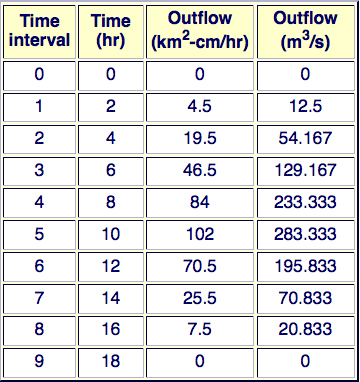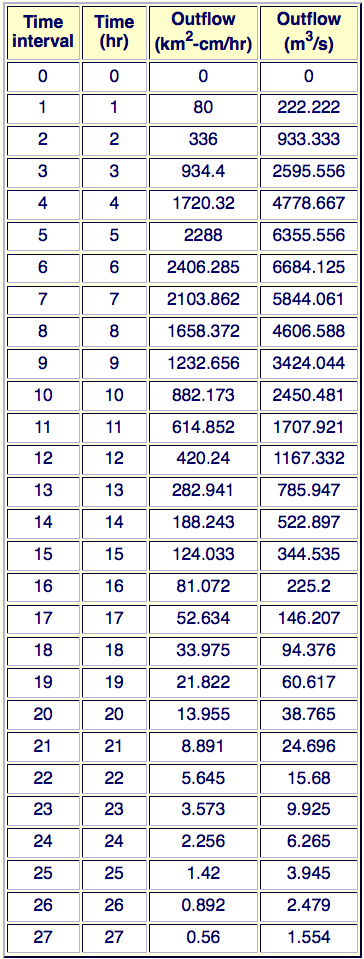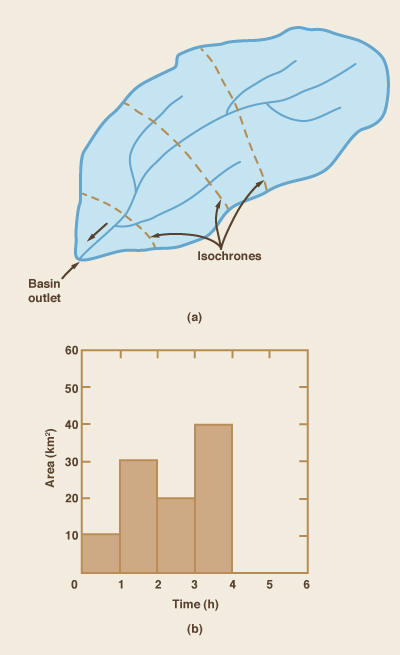CIV E 445 - APPLIED HYDROLOGY
SPRING 2014
LAB No. 12 SOLUTION
-
The accumulated effective rainfall depth is: (0.5 + 1 + 2 + 3 + 1 + 0.5) × 2 = 16 cm.
The total runoff volume is: 45 km2 • 16 cm = 720 km2-cm = 7.2 hm3.
The calculations are shown in the following table.
Time
(hr)Time-area histogram subareas
(km2)Partial flows (km2-cm/hr)
for indicated rainfall incrementsOutflow
(km2-cm/hr)Outflow
(m3/s)0.5
cm/hr1.0
cm/hr2.0
cm/hr3.0
cm/hr1.0
cm/hr0.5
cm/hr0 - 0 - - - - - 0 0 2 9 4.5 0 - - - - 4.5 12.5 4 21 10.5 9.0 0 - - - 19.5 54.167 6 15 7.5 21.0 18.0 0 - - 46.5 129.167 8 - 0. 15.0 42.0 27.0 0 - 84.0 233.333 10 - 0 0 30.0 63.0 9.0 0.0 102.0 283.333 12 - - 0 0 45.0 21.0 4.5 70.5 195.833 14 - - - 0 0 15.0 10.5 25.5 70.833 16 - - - - 0 0 7.5 7.5 20.833 18 - - - - - 0 0 0 0 Sum 45 - - - - - - 360.0 -
The sum of outflow hydrograph ordinates is 360 km2-cm/h.
The integration of the outflow hydrograph results in: 360 km2-cm/h • 2 h = 720 km2-cm = 7.2 hm3, which is the same as the total runoff volume. The same results obtained with ONLINE ROUTING 06 (shown below). ANSWER.

The total amount of rainfall is: 1 + 2 + 5 + 4 + 3 + 0.5 = 15.5 cm/hr • 1 hr = 15.5 cm.
The total volume of runoff is: 1000 km2 • 15.5 cm = 15,500 km2-cm = 155 hm3.
The Courant number is: C = Δt/K = 1 / 2 = 0.5, which results in the following coefficients: 2C1 = 0.4; and C2 = 0.6.
The calculations are shown in the following table.
Time
(hr)N = 1 N = 2 Outflow
(m3/s)Inflow
(km2-cm/hr)Outflow
(km2-cm/hr)Inflow
(km2-cm/hr)Outflow
(km2-cm/hr)0 - 0 - 0 - - 1000 - 200 - - 1 - 400 - 80 222.22 - 2000 - 720 - - 2 - 1040 - 336 933.333 - 5000 - 1832 - - 3 - 2624 - 934.40 2595.556 - 4000 - 2899.2 - - 4 - 3174.4 - 1720.32 4778.667 - 3000 - 3139.52 - - 5 - 3104.64 - 2288 6355.556 - 500 - 2853.71 - - 6 - 2062.78 - 2406.28 6684.125 - 0 - 1650.23 - - 7 - 1237.67 - 2103.86 5844.061 - 0 - 990.13 - - 8 - 742.60 - 1658.37 4606.588 - 0 - 594.08 - - 9 - 445.56 - 1232.65 3424.044 - 0 - 356.45 - - 10 - 267.34 - 882.17 2450.481 - 0 - 213.87 - - 11 - 160.40 - 614.85 1707.921 - 0 - 128.32 - - 12 - 96.24 - 420.24 1167.332 - 0 - 76.99 - - 13 - 57.74 - 282.94 785.947 - 0 - 46.19 - - 14 - 34.65 - 188.24 522.897 - 0 - 27.72 - - 15 - 20.79 - 124.03 344.535 - 0 - 16.63 - - 16 - 12.47 - 81.07 225.2 - 0 - 9.97 - - 17 - 7.48 - 52.63 146.207 - 0 - 5.99 - - 18 - 4.49 - 33.97 94.376 - 0 - 3.59 - - 19 - 2.69 - 21.82 60.617 - 0 - 2.15 - - 20 - 1.62 - 13.95 38.765 - 0 - 1.29 - - 21 - 0.97 - 8.89 24.696 - 0 - 0.78 - - 22 - 0.58 - 5.64 15.68 - 0 - 0.46 - - 23 - 0.35 - 3.57 9.925 - 0 - 0.28 - - 24 - 0.21 - 2.25 6.265 - 0 - 0.17 - - 25 - 0.13 - 1.42 3.945 - 0 - 0.10 - - 26 - 0.08 - 0.89 2.479 - 0 - 0.06 - - 27 - 0.04 - 0.56 1.554 Sum - - - 15499.01
≅ 15500 OK-
The results are the same as calculated by ONLINEROUTING08, shown below.
For the combination 10, 30, 20, 40, the ratio of peak flows is: 21.312 / 21.05 = 1.012.
The combination 40, 10, 30, 20 will produce the largest ratio of peak flows: 20.128 / 18.504 = 1.087.
